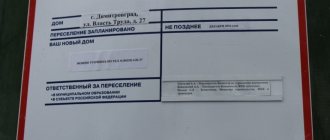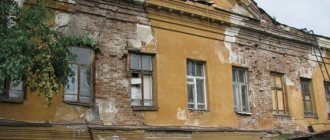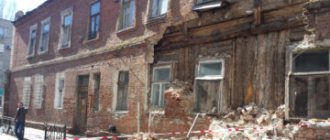Who will participate in the program?
Participants in the program at the initial stage will be regions that have completed the tasks for resettling emergency housing stock established in the national project “Housing and the Urban Environment” for 2019-2024. Among these regions:
- Sakhalin region;
- Karachay-Cherkessia;
- Saint Petersburg;
- Sevastopol;
- Adygea;
- Dagestan;
- Magadan Region;
- Kabardino-Balkaria;
- Saratov region.
What to do if the house is declared unsafe? More details
In 2022, the Astrakhan and Voronezh regions, Kamchatka and Primorsky territories plan to complete the current program of resettlement of citizens, the press service of the Housing and Communal Sector Reform Assistance Fund told TASS.
The procedure for relocating owners from emergency housing
The procedure for relocating from dilapidated or emergency housing consists of several stages.
First you need to submit an application to the interdepartmental commission. Usually its functions are performed by the housing inspectorate under the municipal administration. After this, an examination is carried out, a conclusion is drawn up and a decision is made. Let's look at each stage in detail.
Step 1: Apply
The owner, HOA, tenant, state housing supervision have the right to submit an application to recognize the house as unsafe. Before doing this, they need to contact an independent expert who will inspect the housing, identify all the shortcomings and reflect them in the conclusion. From 2021 this is mandatory. Then the assessment of the condition of the housing is carried out again, but with the participation of a commission.
Documentation
When contacting the interdepartmental commission you will need:
- statement;
- passport;
- an extract from the Unified State Register confirming ownership;
- floor plan of the house;
- expert opinion.
Note! If complaints about the unsatisfactory condition of the house were previously filed with the management company or HOA, it is advisable to submit copies of them along with other documents.
Sample application
Step 2: conducting an examination
During the review of documents, the interdepartmental commission determines the composition of the experts to be involved and organizes work to assess the suitability or unsuitability of a residential building for permanent residence.
During the examination, an apartment building is examined, and a conclusion is drawn up based on the results.
Step 3: document review
The submitted documents along with the conclusion are reviewed by the administration within one month. If the house was damaged as a result of an emergency, the time frame is reduced to 20 days. Additional information from other government agencies is requested through the interdepartmental interaction system.
Step 4: Decide
The decision based on the conclusion is made by a majority vote of the commission, drawn up in triplicate. One of them is sent to the applicant. If the number of votes is equal, the vote of the chairman of the commission is considered decisive. When making decisions, representatives of other bodies may be involved: urban planning, architecture, experts.
30 days are given to make a decision from the date of receipt of the conclusion. If the house was damaged as a result of an accident – 20 days.
Important! If the house is less than 5 years old, the decision and conclusion are sent to the prosecutor’s office to consider whether to hold the developer accountable.
Step 5: Queuing
When a house is declared unsafe, information about the owners is transferred to a government agency to be placed on a waiting list for housing. It can last several years; each region has different settlement periods.
How to find out if a house is in disrepair?
Information about unsafe houses is entered into the register by the authorities of the constituent entities of the Russian Federation. A complete register of emergency houses in all regions of the Russian Federation is posted in the section “Resettlement of emergency housing/Emergency Fund” on the website www.reformagkh.ru.
Question answer
How will citizens be resettled from emergency housing? On the website you need to indicate the address of the house and click on the “printer” button to generate a request for an extract from the register of dilapidated houses. The statement will be sent to the specified email address. The document will list basic information about the house and details of the decision to recognize it as unsafe. If the house is not in the register, the statement will contain the entry “not in the register of emergency houses.”
We hope that the methods listed will help you find information about whether the house is recognized as unsafe.
We understand that authorities may not have entered information into these systems in relation to a particular home. However, no one guarantees that municipalities in a year (according to the adopted bill) will faithfully transfer all information to Rosreestr. Therefore, it is better to look at several sources at once, and if in doubt, contact the local government body itself with an application for information: “Please provide information on the recognition of the house at the address (address) as unsafe and subject to demolition or resettlement, including the results of an inspection of the house by a specialized organization, on the decisions of the interdepartmental commission, as well as on the decisions of the local government on this issue.”
How do I know if a house is included in the relocation program?
Programs for the resettlement of citizens from dilapidated housing stock in all regions of the Russian Federation are posted in the section “Resettlement of dilapidated housing/Programs of constituent entities of the Russian Federation” on the website www.reformagkh.ru.
The website contains information on the resettlement of apartment buildings recognized as unsafe before January 1, 2021. The program is designed for the period until September 1, 2025.
The deadline for relocating each house is established in the regional program of the corresponding constituent entity of the Russian Federation. To receive an extract, you must indicate the address of the house in the section and click the “printer” button to generate a request for an extract from the register of dilapidated houses.
What to do if the house is declared unsafe, but is not in the relocation program?
What kind of bill on all-Russian renovation? More details
If a house is recognized as unsafe before January 1, 2021, it must be included in the resettlement program financed with the participation of the Housing and Communal Services Fund. If for some reason such a house is not included in the program, you should file an application or complaint with the regional authorities or the Housing and Communal Services Fund.
The Housing and Communal Services Fund announced the possibility of resettling more than 50 thousand people from dilapidated housing
The new program for early resettlement of housing recognized as unsafe after January 1, 2021, which the Housing and Communal Services Fund will begin implementing in 2022, will make it possible to additionally resettle more than 50 thousand people in Russian regions. This is stated in the state corporation’s response to Izvestia’s request about what plans the fund has in connection with the order of Russian President Vladimir Putin to accelerate the resettlement of citizens from dilapidated housing.
So far, everything is with the house: who will receive the right to new housing to replace the emergency one?
The State Duma wants to expand the lists of applicants for resettlement from the emergency fund
The Russian leader asked to speed up the resettlement of Russians from emergency housing at a meeting on economic issues, which was held via videoconference on September 28. The President instructed to launch a new housing resettlement program and add to it houses that were recognized as unsafe as of January 2021. He emphasized that Russians living in them should begin to receive high-quality modern housing starting next year.
On September 13, following the results of the second stage of the 20th Congress of the United Russia party, Putin instructed the government to provide funds for the resettlement of dilapidated housing in the regions in the budget for 2022 and the planned years 2023 and 2024. He instructed to allocate 45 billion rubles from the federal budget in 2022 for these purposes.
Currently, the resettlement of emergency housing stock, recognized as such before January 1, 2021, is taking place within the framework of the national project “Housing and the Urban Environment”. The program is designed until the end of 2024 and involves the resettlement of 530.9 thousand people.
The State Corporation “Housing and Communal Services Fund” notes that it financially supports the implementation of regional targeted programs for the resettlement of citizens from emergency housing stock in accordance with federal law dated July 21, 2007 No. 185-FZ “On the Fund for Assistance to the Reform of Housing and Communal Services.” The fund will allocate money for their implementation within the framework of the national project “Housing and Urban Environment”.
The state corporation said that within the framework of the national project it is planned to resettle more than 500 thousand people from 8.99 million square meters. m of dilapidated housing. As part of the federal project, from 2021 to September 1, 2021, 3.7 million square meters have already been resettled. m of such real estate. In total, from 2008 to the present, as part of the implementation of resettlement programs, about 1.3 million people have moved to new apartments from unsuitable houses with a total area of 20 million square meters. m.
It is emphasized that the program of resettlement from emergency housing, recognized as such before January 1, 2021, was completed based on the results of 2020 in Karachay-Cherkessia and the Sakhalin region.
By September 1 of this year, the indicators of the project “Ensuring a sustainable reduction of unsuitable housing stock”, taking into account the implementation of resettlement programs from dilapidated housing at their own expense, were fully met by the Yamalo-Nenets Autonomous Okrug, St. Petersburg and Sevastopol.
“It is expected that by the end of 2021 the program activities will be completed by the Republic of Adygea, the Republic of Dagestan, the Kabardino-Balkarian Republic, the Chechen Republic, the Magadan and Saratov regions. At the same time, more than 25 constituent entities of the Russian Federation have postponed the completion of the resettlement of emergency housing from 2025 to earlier years,” the Housing and Communal Services Fund reported.
According to data provided to the state corporation by the constituent entities of the country, the volume of dilapidated housing requiring resettlement in the Russian Federation as a whole at the beginning of 2021 was 16 million square meters. m, at the beginning of 2020 - 17.3 million sq. m. At the beginning of 2021, the volume of such housing reached about 20 million square meters. m, of which 11.3 million sq. m were declared hazardous in 2017–2020. m.
In August, Prime Minister Mikhail Mishustin said that the authorities would send more than 20 billion rubles to some regions to eliminate dilapidated housing. According to him, 14 regions are ready to build more than 40 important infrastructure facilities ahead of schedule.
In May, the prime minister said that the plan for resettlement from emergency housing in 2019–2020 was completed by more than 200%.
Residents refuse to move out of their dilapidated home
According to Shloma, some enterprising homeowners in Khrushchev-era apartment buildings deceived buyers, promising them that the house would soon be demolished and all owners would receive new apartments, but this was not true. And now this is even more impossible to happen - the resettlement will most likely drag on indefinitely.
The Village. News from Moscow, St. Petersburg. People, places, events. Use of The Village materials is permitted only with the prior consent of the copyright holders. All rights to pictures and texts in the News section belong to their authors.
According to unverified information, residents of demolished dilapidated buildings will be resettled in new houses, which are located on Onezhskaya, Flotskaya, Malaya Botanicheskaya streets. And also on Shipbuilding, Bekhterev, Svoboda, Nagatinsky Zaton, Izumrudnaya, Shumilov and Ryazansky Avenue.
Dilapidated housing where Moscow residents can be resettled
The service for advertising the sale and rental of real estate on the RBC.Real Estate website has switched to Yandex technologies.
Thus, resettlement from houses located in the Central, Zelenogradsky, Troitsky and Novomoskovsky administrative districts of Moscow is carried out within the boundaries of these administrative districts. Resettlement from an area that does not have borders with other areas of Moscow is carried out within the boundaries of the administrative district, which includes the specified area. This indicator depends on the material from which the house is built - brick, cinder block, wood. For wooden houses, the maximum level of structural wear should not exceed 65%, and for stone houses - 70%.
Oddly enough, even the owners of purchased or privatized apartments count on improving their living conditions due to the large number of relatives registered in the apartment.
What should we focus on in general?
Despite the decision of the authorities to leave some Soviet buildings only for major renovations, 2025 is called the year when all five-story buildings in Moscow that disfigure the city will be demolished, and not just the so-called Khrushchev buildings. To do this, it will be enough for a five-story Soviet creation to:
- was built from blocks;
- objectively constituted an emergency dwelling;
- could not be safely renovated due to the architectural nuances of the old design;
- occupied an important area in the major transformation of the entire microdistrict or block;
- was located at a real distance from the first and second metro rings;
- was located on the route of a major highway.
But you shouldn’t expect that all Soviet houses will fall under dilapidated housing. Many of them can legally serve for another 50 years. The government is targeting buildings that have 10-20 years left, so it is useful to constantly check the lists of demolished buildings in Moscow.
In the meantime, the large-scale liquidation of dilapidated housing in Moscow in 2021, unfortunately, will not affect the region and the Moscow region. But conversations about this are already actively beginning. In the regions, the initiative has already been taken up in practice, so all owners of old Soviet housing need to believe and expect that their improvement is also not far off.
What is the order of demolition and resettlement?
According to the approved official plan for the Demolition Program for dilapidated five-story buildings, the resettlement of residents of outdated buildings will proceed in waves:
- First, citizens whose houses are included in the list of dilapidated housing will receive improved new apartments in the same area where they lived, or in the neighborhood, but with more developed infrastructure around them. To do this, new starting houses will be pre-built or prepared in each such zone.
- Completely vacated five-story buildings will be razed to the ground, and the areas underneath them will be cleared.
- In clean areas, new buildings will be built for the next batch of residents who are subject to the demolition of five-story buildings in 2021, and so on.
This method relieves residents of the inconvenience that usually accompanies moving - searching for a new job, new kindergartens, schools. Therefore, Muscovites are eagerly waiting to see if their house will be renovated this or next year.
It is not difficult to find out whether a home is covered by the Program. Firstly, just check the open, current list of house demolitions - all the addresses from it are below, right here. Secondly, as soon as a building with a tenant’s apartment comes under renovation, a special notification is sent to the owner of the apartment.









